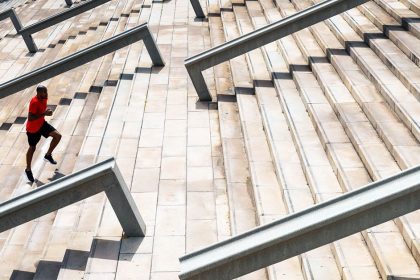Fitness researcher Michael Easter recently appeared on the Huberman Lab podcast, where he detailed an alternative to traditional running that combines cardiovascular and strength training—weighted walking, also known as rucking.
Easter’s research began with the observation of how humans have historically exercised. In discussing the roots of this exercise, Easter highlighted the military’s ongoing reliance on it as a primary form of physical training. His insights shed light on the surprising effectiveness of this often-overlooked activity as a fat-burning solution while preserving muscle mass.
During his conversation with Andrew Huberman, Easter emphasized the need to reassess what constitutes effective exercise. While many focus on running or high-intensity workouts for fat loss, he introduced a method that he believes we were inherently designed to perform.
The Origins of Weighted Walking
This practice of carrying weight while walking connects to humans’ early lifestyles as hunters. Easter stated, “So we go up to the Arctic, we’re hunting. Eventually successfully hunt a caribou, and we’re taking every usable part that we can, so we load our packs with all this weight. It’s like 100-something pounds in this damn pack, and we start walking back to camp.” He noted the uniqueness of humans among mammals, as no other species can carry significant weight for long distances.
This realization inspired Easter’s research into weighted walking, revealing its forgotten benefits. According to him, our capability to carry load has fundamentally shaped our physical identity.
Weighted Walking in Modern Fitness
Easter pointed out that despite the popularity of running and marathons, few people regularly engage in weighted walking. He remarked, “Now, the thing is, when you look at running, plenty of people run. Running and marathons, that is a popular activity. But how many people are just carrying weight as a regular form of exercise? The answer was really not that many.”
Interestingly, the military continues to integrate weighted walking into their training regimens. “Rucking is sort of the main activity of physical training in the military. Just throwing weight in a backpack and going for a long walk,” he explained. This combination of cardio and strength training offers a unique advantage for those looking to maximize their fitness.
Easter has slightly adjusted his terminology, favoring the phrase “walking with weight” over rucking, noting the dual benefits such as enhanced cardiovascular stimulation while loading the skeletal and muscular systems.
The Caloric Burn of Weighted Walking
When comparing weighted walking to standard walking or running, Easter revealed that it generally burns more calories per mile. “It generally will burn more calories per mile than walking or running, and that is simply because you’ve added extra weight,” he said. He acknowledged that while runners might cover more distance in a shorter time, the added weight in walking significantly increases the caloric burn when comparing the same distance.
For those who shy away from running or find traditional walking insufficiently stimulating, weighted walking serves as a perfect middle ground.
Easter also referenced a small study conducted with a group in Alaska, where participants carried heavy packs into the mountains over a week. The results were impressive: the group shed significant weight solely from fat while experiencing a slight gain in muscle mass. He stated, “This is rare, considering that most people who lose fat also lose some amount of muscle in the process.”
This exploration into the benefits of weighted walking presents an exciting potential for anyone seeking effective fitness solutions without the drawbacks of running. As Easter highlighted, this method uniquely integrates strength and cardio, making it a versatile addition to any workout routine.
In conclusion, as more people look for viable alternatives to conventional exercise, the principle of weighted walking surfaces as an engaging and efficient option. The simplicity of this form of exercise aligns with the natural designs of our bodies, underscoring its potential as a beloved choice for fitness enthusiasts everywhere.






